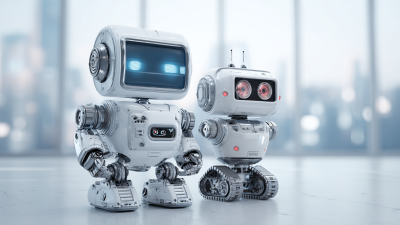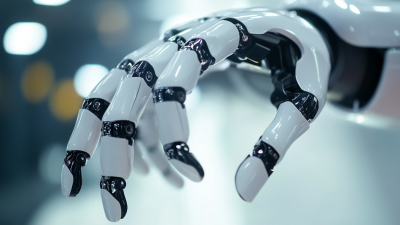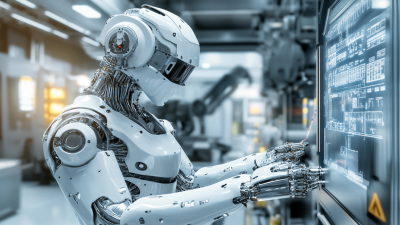

14, Raghava Enclave, Transport Road, Secunderabad, Hyderabad (500009)
©2024 All Rights Reserved by excitechrobot.com
In today's rapidly evolving technological landscape, the integration of Autonomous Robots into everyday applications is transforming various industries and enhancing our daily lives. These intelligent machines, capable of functioning independently, present unique opportunities to improve efficiency, safety, and productivity across multiple sectors, from healthcare and manufacturing to smart homes and logistics. As we explore the potential of Autonomous Robots, it is crucial to understand not only their functionalities but also the strategies for effectively harnessing their capabilities. This guide will delve into practical approaches for implementing Autonomous Robots in various settings, emphasizing the importance of adaptation and innovation in leveraging their power. By embracing this technology, individuals and organizations can revolutionize their operations and unlock new levels of convenience and effectiveness, paving the way for a future where Autonomous Robots are integral to our daily routines.

Explore the potential of integrating these technologies into your business strategies and the myriad of benefits they can offer. Invest in understanding Autonomous Robots and their applications to stay ahead in the rapidly changing technological landscape.
The autonomous robots market is experiencing significant growth, with projections indicating a transformative impact on various sectors by 2024 and beyond. According to recent research, the AI agents market alone is expected to reach a staggering USD 236.03 billion by 2034, driven largely by advancements in machine learning and natural language processing. This rapid evolution in technology will undoubtedly pave the way for enhanced applications of autonomous robots across industries, particularly in fields like automotive, where the lidar market is expected to expand to $9.5 billion.
**Tips**: To effectively harness the power of autonomous robots in everyday applications, companies should prioritize the integration of automated solutions into their existing workflows. This can involve identifying repetitive tasks that can be streamlined through robotic assistance. Additionally, investing in employee training can facilitate smoother collaboration between humans and robots, enhancing productivity and operational efficiency.
As we approach 2025, key trends such as the rise of humanoid and service robots will further influence market dynamics. Industries like construction are already seeing digital transformation, leveraging robotics to optimize operations. Staying informed about these developments will be crucial for businesses looking to capitalize on the opportunities presented by autonomous technologies.
**Tips**: Companies can stay ahead by regularly reviewing market forecasts and aligning their investment strategies with anticipated growth areas. Engaging with innovation hubs and partnerships can also foster a culture of innovation, ensuring that organizations remain agile in the ever-evolving landscape of technology.

In today’s fast-paced economic environment, enhancing efficiency within warehousing operations is crucial. Autonomous robots are transforming the supply chain by optimizing various tasks traditionally performed by human workers. These robots streamline processes such as inventory management, picking, and packing, significantly reducing the time required to fulfill orders. By utilizing advanced technologies like machine learning and computer vision, autonomous robots can navigate complex environments, avoiding obstructions and adapting to changes in real-time.
Moreover, the integration of autonomous robots leads to cost savings and improved accuracy in inventory control. With the ability to operate continuously without fatigue, these machines can handle repetitive tasks, allowing human workers to focus on more strategic roles. This shift not only enhances operational efficiency but also minimizes human error, leading to better inventory management. As warehouses embrace automation, the implementation of autonomous robots is becoming an essential component of modern supply chain operations, driving innovation and competitiveness in the industry.
The rise of autonomous delivery robots is reshaping the retail landscape and enhancing last-mile logistics solutions. These robots provide an efficient method for transporting goods directly to consumers, minimizing the need for traditional delivery methods that often involve multiple handling steps. By navigating urban environments and dealing with obstacles independently, they help streamline operations and reduce delivery times, benefiting both retailers and customers.

In grocery and consumer goods sectors, autonomous robots have become invaluable assets. They not only operate at lower labor costs but also improve service reliability and speed. As they are deployed in urban areas, the robots can easily adapt to real-time changes in traffic and customer demands, ensuring that goods are delivered efficiently. Moreover, their presence enables retailers to expand their service areas without the need for additional physical infrastructure, ultimately leading to a more sustainable and responsive delivery model.
In recent years, the integration of autonomous robots in healthcare has transformed patient care and operational efficiency.
Service robots are now employed in various capacities, from assisting in rehabilitation to providing companionship and medication reminders at home.
These robots enhance the quality of care by allowing healthcare professionals to focus more on critical tasks while improving patient interaction.
Tips for Implementing Service Robots:
1. Assess Operational Needs: Before integrating robots into your healthcare facility, conduct a thorough assessment of what tasks can be automated to maximize efficiency.
2. Training and Support: Ensure that healthcare staff receive adequate training on how to work alongside robots, as this will ease the transition and enhance collaborative care.
3. Patient Engagement: Engage patients by informing them about the technology and its benefits. A positive attitude towards robots can foster better acceptance and interaction.
The use of AI in healthcare extends beyond robots, encompassing software for data analysis and decision-making, which helps in improving clinical outcomes. The future of healthcare lies in advancements that not only optimize operational capabilities but also enrich patient experiences through cutting-edge technology.
The integration of artificial intelligence (AI) and machine learning is revolutionizing the capabilities of autonomous robots, making them increasingly useful in everyday life. From household cleaning to personal assistance, these technologies empower robots to learn from their surroundings and optimize their functions. For example, modern robotic vacuum cleaners utilize AI to map homes, navigate around obstacles, and even adapt to the cleaning preferences of their users, ensuring an efficient and effective cleaning experience.
**Tips:** To maximize the benefits of autonomous robots at home, ensure that you regularly update their software to improve their learning algorithms. Additionally, consider setting specific cleaning schedules to enhance the robot's ability to adapt to your routine. By engaging with the features offered, such as customizable cleaning modes, you can harness the full potential of these intelligent devices.
As the field of AI and machine learning continues to advance, we can expect autonomous robots to become more capable of handling complex tasks. Whether it's a robotic chef preparing meals or a garden assistant aiding in planting and weeding, these innovations are on the brink of becoming indispensable in our daily lives. Embracing these technologies opens the door to a future where autonomous robots act as supportive companions in our homes, contributing to an increased quality of life.
| Application Area | Robot Type | AI Techniques Used | Benefits | Current Adoption Rate |
|---|---|---|---|---|
| Household Cleaning | Robotic Vacuum | Computer Vision, SLAM | Time-saving, Efficient cleaning | 30% |
| Healthcare Assistance | Service Robot | Natural Language Processing, Machine Learning | Support for elderly, Increased patient engagement | 15% |
| Agriculture | Agricultural Drones | Image Recognition, Data Analysis | Precision farming, Yield improvement | 20% |
| Delivery Services | Delivery Robots | Path Planning, Obstacle Detection | Convenience, Cost-effective | 10% |
| Retail | Shopping Assistants | Facial Recognition, AI Chatbots | Enhanced customer experience, Sales increase | 12% |






